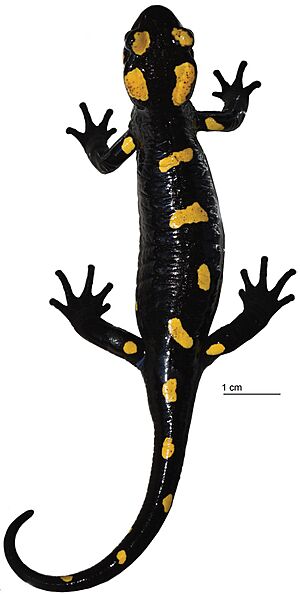North African fire salamander facts for kids
Quick facts for kids North African fire salamander |
|
|---|---|
 |
|
| Conservation status | |
| Scientific classification | |
| Genus: |
Salamandra
|
| Species: |
algira
|
The North African fire salamander (Salamandra algira) is a special type of salamander found in North Africa. It lives in countries like Algeria, Morocco, and a small Spanish area called Ceuta. Scientists think it might also live in Tunisia. These salamanders usually make their homes in cool, damp places like temperate forests, near rivers, and even inside caves. Sadly, their homes are shrinking, which puts them at risk.
Where They Live and Their Homes
The North African fire salamander is found only in northwestern Africa. This means it is an endemic species, living naturally nowhere else in the world! You can find them in the Rif Mountains and Middle Atlas Mountains in northern Morocco. They also live in the Spanish area of Ceuta and the coastal mountains of northern Algeria.
These salamanders can live at different heights, from about 260 feet (80 meters) up to around 8,000 feet (2,450 meters) high. They love the floor of moist forests, especially those with oak and cedar trees. They often hide under tree roots and stones to stay safe and cool. Some have even been found living inside caves!
Reproduction and Life Cycle
Most North African fire salamanders are ovoviviparous. This is a big word that means the mother keeps her eggs inside her body until they hatch. The young salamanders get all their food from the egg yolks while they are inside. A mother can have anywhere from eight to 50 babies in one group!
However, in one specific area called Tingitana, things are a bit different. Here, the young salamanders seem to get some of their food from the mother's body, not just the egg yolk. This is called viviparous reproduction. When the babies are ready, the mother releases about fifteen young salamander larvae into streams or pools.
Conservation Status
Even though you might find many North African fire salamanders in some places, they are quite rare in others. Their homes are also spread out and broken up, which makes it harder for them to thrive.
The biggest danger they face is the destruction of their forest homes. People sometimes cut down trees or change the land, which takes away the salamanders' habitat. Other problems include changing forest streams for irrigation (watering crops), too many animals eating the plants (overgrazing), and sometimes people collecting the salamanders to sell as pets.
Because of these threats, the International Union for Conservation of Nature (a group that studies wildlife) has listed the North African fire salamander as a "vulnerable" species. This means they need our help to protect their homes and make sure they can survive for a long time!


